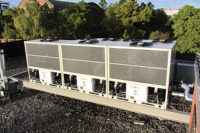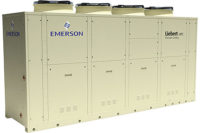While large chiller systems carry enormous energy costs for building owners, enterprising companies and contractors are striving to lessen the burden of this expense by optimizing chiller systems to achieve greater efficiency.

|
| At Marlins Park, the new MLB stadium located in Miami, Carlos Diaz, cofounder and COO of Entic, said, “They’re very serious about sustainability and operational efficiency.” Entic’s energy dashboard is shown here at work on a smartphone screen inside the park. |
The optimization process requires a careful, conscientious approach, beginning with a thorough evaluation of the chiller system. Ultimately, there are substantial energy savings possible through this process, which is precisely what catches the attention of prospective clients.
“Facility managers and owners are increasingly interested in optimization projects because they typically reduce the cooling production cost by 20-50 percent,” said Mike Flaherty, general manager of tekWorx LLC, which provides engineering services and adaptive control systems for optimizing the energy performance of chiller and boiler plants.
Those paying the bills recognize the value in such a reduction in energy use, said Carlos Diaz, cofounder and COO, Entic LLC, which specializes in HVAC and central plant peak performance.
“It’s a business issue that directly affects the bottom line,” Diaz said. “Folks at the top of an organization, such as the CFO and CEO, get it pretty quickly. HVAC energy expenditures are a major line item in the overall budget and just by correcting a few inefficiencies in the current system, a commercial building can save hundreds of thousands of dollars a year in energy costs.”
The Optimization Process
According to Flaherty, there are three phases to a chiller optimization project: evaluation, implementation, and measurement and verification.
In the evaluation phase, Flaherty said there are three main areas that must be reviewed: the mechanical infrastructure, the control system, and the operational strategy.
On the mechanical side, he said, “You evaluate the equipment they’ve got, the condition of the equipment, how the equipment is all connected together, and how it’s been maintained, and you take lots of measurements about the power that’s being consumed and process variables like temperatures, pressures,
flow, and heat.”
From the control point of view, Flaherty said, “You have to look at how the system is being controlled. What kind of a control system do you have in it? Is there sufficient instrumentation present, and is it calibrated? What kinds of control strategies do you have for sequencing equipment? What temperatures and pressures do you operate at, and why?”
And for the operational evaluation, he said, “This comes down to the idiosyncratic issues of every job site. Are there any site limitations or equipment issues that require a workaround? What are your operators doing? Are they doing the wrong thing because they don’t understand the impact of their actions or — more likely — because they’ve never been trained?”
After performing a thorough evaluation, Flaherty said, “You can determine what could and should be done in order to improve the efficiency.”
And, he pointed out, all of the recommendations will fall into one of the three main categories, such as repairs and changes to the mechanical system, adjustments to the control strategy, and operating changes, which usually includes training for the operators.
Carlos Borja, CEO of Weathertrol, a mechanical service contractor based in Miami, confirmed it’s very important during the evaluation phase to begin by looking at the original chiller system design.
“The initial step in the chiller optimization process starts with understanding the original facility requirements and creating a baseline of operation. Hopefully, there is available information on the original system design. Confirming the existing operational sequence versus the original design establishes the range of improvement available in any system,” he said.
Borja continued, “Then it becomes a matter of verifying the proper operation of all the mechanical and control components. Using a variety of testing instruments and existing building management systems, we can calculate the operating state of the system and identify any critical failures that would be causing undue efficiency loss. Collecting data over a period of time will then help establish what measures can be taken to realize cost-effective efficiency improvements.”
Borja also reiterated that each optimization process is customized to the specific site. “We are able to apply a variety of solutions based on the type of system, the specifics of each site, and the needs or objectives of the facility owners.”
Getting Involved in Optimization
While many contractors may stick just to maintenance, Weathertrol is a prime example of a contractor going beyond the traditional mindset to assist its customers with the chiller optimization process.
“Chiller optimization takes a systematic approach that involves several parties, including the owner, manufacturer, design team, and building management. As a contractor, we must bring expertise not only in mechanical systems, but also in integration with other building systems,” Borja said. “The reason for this is because, ultimately, total energy consumption relies on the most efficient system operation — not necessarily the most efficient chiller state. Traditional maintenance and repair is only one deliverable, but optimization incorporates benchmarking and constant system validation to make sure peak performance is being achieved. We owe facilities more than just fixing mechanical problems.”
Borja and Diaz noted that Weathertrol and Entic have successfully partnered together on optimization projects. According to Diaz, Entic can take referrals from contractors or work with them long term.
Diaz added, “Weathertrol has been in the business for 45 years, and it’s moving into energy management solutions using Entic’s technology. Weathertrol really gets it. The company understands the value that technology brings to the customer and to its business.”
However, according to Flaherty, many mechanical contractors are missing out on a great opportunity — and potential for profit — by failing to take any initiative in chiller optimization. In his experience with these projects, his company is involved on the front end, and it isn’t until tekWorx begins recommending mechanical repairs as part of the optimization process that the local mechanical contractor becomes involved.
“If HVAC contractors realized the financial savings for their customers and the corresponding business opportunity for their firm, they might start going around and asking, ‘How’s your chilled water process going? And would you be interested in reducing the energy cost?’” Flaherty said.
“If they were to call us up [with prospective project leads], we would be happy to work with them. But the way it always seems to go is the owner or engineer gets us involved first, then we ask the client who their favorite local contractor is. They say, ‘it’s Bob,’ then we tell Bob what he needs to do. But Bob could make a lot more money if he were involved on the front end identifying the opportunity,” he said.
Plus, Flaherty added, “Our experience definitely shows that when someone introduces an owner to this kind of money-saving idea, the owner always uses that party for doing the actual work. And it’s usually done without a competitive bid.”
Saving Money and More
There are plenty of ways for contractors to make the case for optimization to customers. Chiller optimization can result in very significant benefits, according to Borja.
“Some benefits include immediate returns in lower energy bills, extending life expectancies on equipment, delaying capital expenditures, leveling of costs for the operations of systems, and creating better accountability for the ultimate performance of an HVAC system — not just chiller operation,” he said.
Flaherty also noted the numerous benefits of optimization.
“Obviously, you’re saving the money,” he said. “The second benefit is you make equipment run at its most efficient points, so it’s subjected to less stress, which reduces maintenance cost and increases [equipment] life. And the other benefit is that when the system is optimized and running properly, operators can focus on other things.”
Flaherty has been involved in more than 200 successful optimization projects since he cofounded tekWorx in 2001. One of the most recent was a project at Chrysler’s 5.5 million-square-foot headquarters in Auburn Hills, Mich.
Since optimizing its chiller system, Chrysler is saving $1 million a year, Flaherty said. The corporation will recoup its investment in less than two years.
In addition to the recurring energy savings, Flaherty noted that Chrysler also received a substantial rebate from the utility, which reduced the payback period even further.
Diaz also shared success stories about optimization projects Entic has been involved with.
“At Broward Health Medical Center in Florida, we were able to identify several inefficiencies, optimize the chiller plant, and reduce energy costs by $311,000 in the first year. That’s significant money in an industry experiencing a lot of external economic pressures. The CFO there told us that unlike other cost-saving initiatives, ours was something he could see clearly in his operating budget. We’re now moving onto other buildings in their parent group,” he said.
Diaz continued, “Another good example is MLB’s Marlins Park, the league’s newest stadium and only LEED Gold-certified ball diamond. They’re very serious about sustainability and operational efficiency. We were able to gain important insights into the building’s pumping, cooling, and water consumption, and remain on track to reach the customer’s goal of reducing related energy consumption.”
Publication date: 5/12/2014
Want more HVAC industry news and information? Join The NEWS on Facebook, Twitter, and LinkedIn today!











